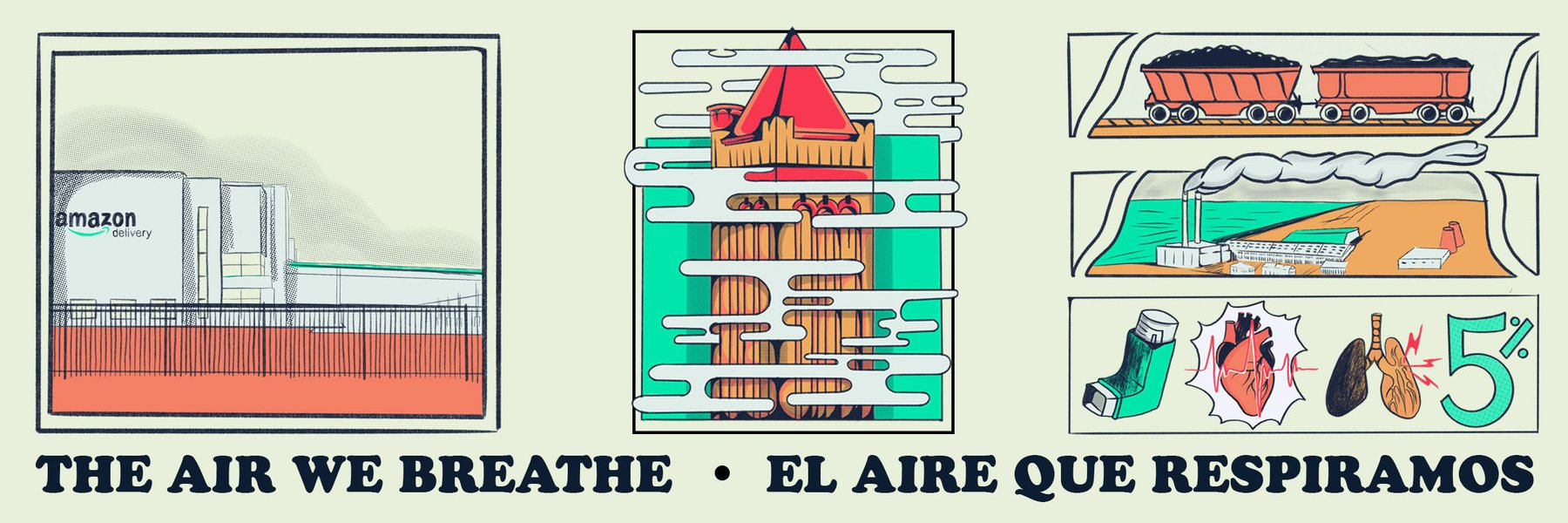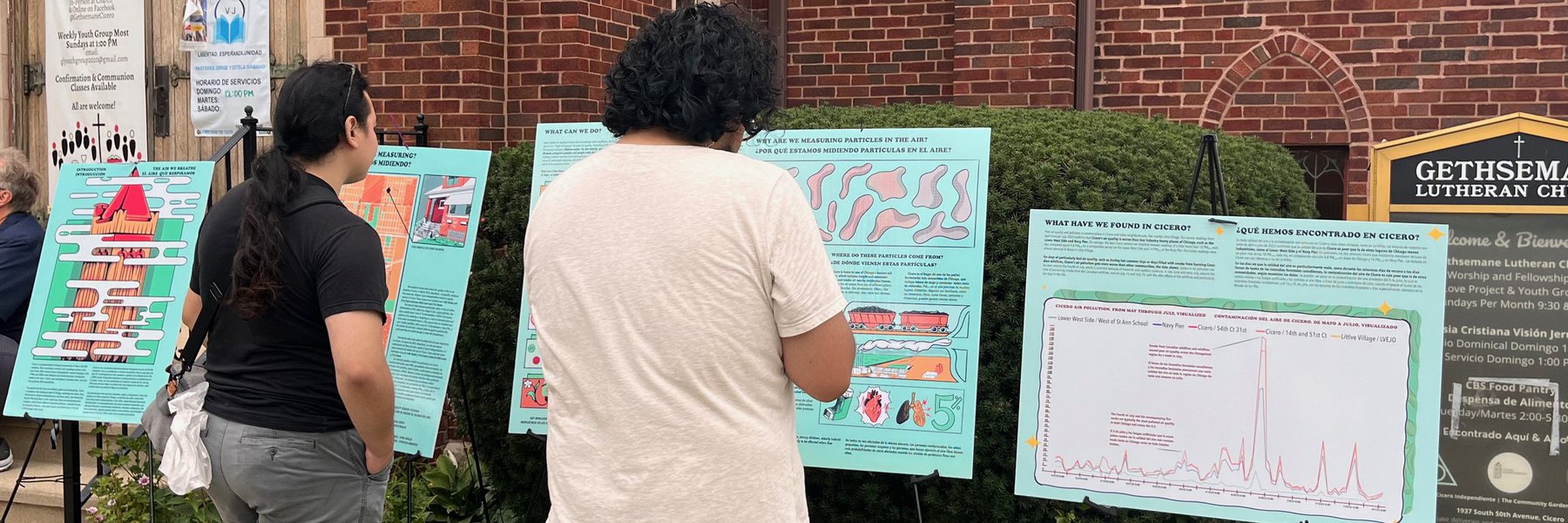Beginning in the late 1980s, county officials in Riverside, California, approved dozens of new business projects that would transform an area of the Jurupa Valley from a dairy farm capital to a hub for warehousing and diesel trucks.
In the following decade, developers snapped up sprawling farmland and turned it into projects like a 125-acre Costco distribution complex or an almost million-square-foot warehouse used by Walmart.
In 2002, David Danelski, then an investigative reporter with the Riverside Press-Enterprise, uncovered the decisions that led to Mira Loma’s transformation, using public records to trace development back to a document approved in 1987. Called the “Jurupa Community Plan,” the document mapped a future of more than 5,000 acres of industry on top of current farmland in areas of the county that already suffered poor air quality from freeways and downwind smog from Los Angeles and Orange County
“Basically Riverside County decided to bring in more pollution sources where their pollution was already at its worst,” Danelski said.
Danelski, now retired from journalism, shared how he reported the story as well as how local governments assess the environmental consequences of building new businesses, highways or housing. In our previous air quality guide, we focused on complaints, fines and violations that might point you toward polluters. The public records you’ll be able to find using this guide might help you answer what your local government is doing to improve your air quality beyond issues of compliance or how polluters ended up in your community in the first place.
Environmental impact statement
An environmental impact statement is “a government document that outlines the impact of a proposed project on its surrounding environment.” The use of this type of document began after it was codified for federal government agencies in the National Environmental Policy Act (NEPA) of 1969. Under NEPA, an environmental impact statement is required for any project initiated, financed or permitted by the government, with some exceptions. It’s important to note that an environmental impact statement doesn’t prohibit harm to the environment in any way; it just requires the project or business to identify and disclose any harms in advance. The EPA keeps a database of all environmental impact statements filed by federal agencies.
While the EPA database may turn up important information on federal projects, local versions of the environmental impact statement can give you more information about projects right around the corner. These regional impact statements are often required by law because many states and local governments mirrored the specifics of NEPA in their own environmental rules. You can ask a local planner how the process works near you or dig directly into your local environmental policy or environmental quality acts.
For example, Alabama requires an environmental review process for several state agencies and Minnesota has a specific “Air Emissions Risk Analysis” as part of its environmental impact statement. As for cities, both Washington, D.C., and New York City have their own environmental review process.
With an environmental impact statement in hand, you can scrutinize the decision-making process that brought a project to life. Don’t be afraid to be skeptical of these documents, Danelski suggests, because the analyses underpinning the documents sometimes prioritize speed and ease instead of accuracy.
“Really look closely at their analysis and shop it around with academic experts,” Danelski said.
In Portland for example, reporter Jayati Ramakrishnan of the Oregonian covered a major freeway proposal that originally stated that there would be no significant environmental impact, a conclusion that was later called into question by the Federal Highway Administration.
An environmental impact statement for a highway in South Carolina illustrates a more comprehensive proposal, one that included funding for a community air-monitoring project, reported Adam Park of the Post and Courier.
If there is a project that you’re interested in seeing the environmental impact statement for, take a look at this request for the environmental review of an Amazon warehouse in Cicero, Illinois. You can file your own version of the request here.
Air pollution control and clean-up
Air pollution control plans are your local government’s blueprint for meeting air quality standards. They can be included in a state-wide program like this one in Texas or a more local one like this air pollution control plan for Middlesex County, New Jersey.
You can use these big-picture plans to discern what the broader emissions targets of your local government are and to compare those goals with smaller steps like requiring environmental impact statements or doubling down on compliance.
Melissa Montalvo of the Fresno Bee reported on the failure of the local air quality board to fulfill its own plans, leading to the resignation of three public members of its advisory board. In St. Louis, Mark Schlinkmann covered changes that would allow the local air control board to update its status as non-compliant with federal rules and make a new control plan.
In addition to the broader air pollution control plans, local governments follow clean-up plans like the State Implementation Plans (SIPs) approved by the EPA to fulfill the requirements of the Clean Air Act. Unlike the control plans that list broad air pollution goals, these plans describe a specific set of actions being taken to improve an air quality problem. SIPs can give you an idea of the areas that your local air quality agency is currently working on improving. New Mexico, for example, has a portal that lists all recently proposed and approved plans.
In 2016, three environmental groups sued the EPA for not making a final decision on how to enact a clean-up plan in Fairbanks, Alaska, reported Dan Joling for the Associated Press. In California, Gregory Weaver at the Fresno Bee reported on the failure of scheduled clean-up plans in the San Joaquin Valley due to mismanagement of planning and budget as well as objections from the EPA.
Studies on the health impacts of air pollution
If your local government is as interested in air pollution as you are, it may have already commissioned its own studies. To date, the New York City Community Air Survey is one of the most hyperlocal and comprehensive studies.
Like control plans and clean-up plans, studies on the health impacts of air pollution give you a sense of what your local government already knows is a concern and how they prioritize improving air quality.
In 2019, Christopher Magan at the St. Paul Pioneer Press reported on a study from the state health department that linked 10 percent of deaths in the Twin Cities metropolitan area to air pollution. In 2020, the Houston Health Department studied the level of cancer-causing air toxics at three of the city’s monitoring sites.
What’s next?
Once the Jurupa Community Plan was approved and development began, many of the industrial projects were approved without an environmental impact statement. County officials admitted to Danelski that development was happening so fast that they didn’t undertake an environmental review process for proposed projects.
More than a decade passed before the county considered the cumulative impact of diesel trucks that the warehouses attracted. By that time, the area’s farms, freeways and warehouses had combined to create some of the worst air quality in the country.
Town planning involves a bevy of documents regarding a proposed project’s impact on the environment, Danelski said, and you can find them if you know what to look for or who to ask.
“I would really urge reporters to talk to a low-level county or city planner and ask them what projects have to file under [their local air quality act]’,” Danelski said.
For more environmental transparency inspiration, check out our previous air pollution records guides on how local governments set environmental and health standards and how they enforce air pollution rules. If you have a great example of environmental public records reporting you’ve done, reach out at dillon@muckrock.com. We’d love to highlight additional examples of great work in MuckRock’s weekly newsletter.
Header image by B Brown via Shutterstock and is not licensed for reuse without prior authorization.





